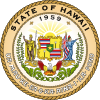Hawaii (island)
 Landsat mosaic, 1999–2001 | |
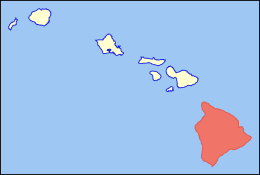 Location in the state of Hawaii | |
| Geography | |
|---|---|
| Location | 19°34′N 155°30′W / 19.567°N 155.500°W / 19.567; -155.500 |
| Archipelago | Hawaiian Islands |
| Area | 4,028 sq mi (10,430 km2) |
| Area rank | 75th, largest island in the United States – 1st |
| Highest elevation | 13,803 ft (4,207.2 m)[1] |
| Highest point | Mauna Kea |
| Administration | |
United States | |
| State | Hawaii |
| Symbols | |
| Flower | Red Pua Lehua (ʻOhiʻa blossom)[2] |
| Colour | ʻUlaʻula (red) |
| Largest settlement | Hilo |
| Demographics | |
| Population | 185,079 (2010) |
| Pop. density | 46 /sq mi (17.8 /km2) |
Hawaiʻi (/həˈwaɪ.i/ (![]() listen) hə-WY-ee; Hawaiian: [həˈvɐjʔi]) is the largest island located in the U.S. state of Hawaii. It is the largest and the southeasternmost of the Hawaiian Islands, a chain of volcanic islands in the North Pacific Ocean. With an area of 4,028 square miles (10,430 km2), it has 63% of the Hawaiian archipelago's combined landmass, and is the largest island in the United States. However, it has only 13% of Hawaiʻi's people. The island of Hawaiʻi is the third largest island in Polynesia, behind the two main islands of New Zealand.[3]
listen) hə-WY-ee; Hawaiian: [həˈvɐjʔi]) is the largest island located in the U.S. state of Hawaii. It is the largest and the southeasternmost of the Hawaiian Islands, a chain of volcanic islands in the North Pacific Ocean. With an area of 4,028 square miles (10,430 km2), it has 63% of the Hawaiian archipelago's combined landmass, and is the largest island in the United States. However, it has only 13% of Hawaiʻi's people. The island of Hawaiʻi is the third largest island in Polynesia, behind the two main islands of New Zealand.[3]
The island is often referred to as the Island of Hawaiʻi,[4] the Big Island, or Hawaiʻi Island to distinguish it from the state. Administratively, the whole island encompasses Hawaiʻi County.
As of the 2010 Census the population was 185,079.[5] The county seat and largest city is Hilo. There are no incorporated cities in Hawaiʻi County (see List of counties in Hawaii).[6]
Contents
1 History
2 Geology and geography
2.1 Volcanism
2.2 Great Crack
2.3 Hilina Slump
2.4 Earthquakes and tsunamis
2.5 Volcanic fog
2.6 National protected areas
2.7 Adjacent counties
3 Demographics
4 Government and infrastructure
4.1 County government
4.2 State government
5 Economy
5.1 Top employers
6 Education
7 Transportation
7.1 Roads
7.2 Airports
7.3 Seaports
8 Places of interest
9 Maps
10 Communities
10.1 Census-designated places
10.2 Unincorporated communities
11 See also
12 References
13 External links
History

James Kealoha Beach, "Carlsmith Beach Park", in Hilo
Hawaiʻi is said to have been named after Hawaiʻiloa, the legendary Polynesian navigator who first discovered it. Other accounts attribute the name to the legendary realm of Hawaiki, a place from which some Polynesian people are said to have originated, the place where they transition to in the afterlife, or the realm of the gods and goddesses. Captain James Cook, the English explorer and navigator who was captain of the first European expedition that discovered the Hawaiian Islands, called them the "Sandwich Islands" after his patron, the Earl of Sandwich.[7] Cook was killed on the Big Island at Kealakekua Bay on 14 February 1779, in a mêlée which followed the theft of a ship's boat.[8]
Hawaiʻi was the home island of Paiʻea Kamehameha, later known as Kamehameha the Great. Kamehameha united most of the Hawaiian islands under his rule in 1795, after several years of war, and gave the kingdom and the island chain the name of his native island.[9]
Geology and geography

Aerial view, 3D computer-generated image

Rotatable image (click for rotatable version)
According to the U.S. Census Bureau, the county has a total area of 5,086 square miles (13,170 km2), of which 4,028 square miles (10,430 km2) is land and 1,058 square miles (2,740 km2) (20.8%) is water.[10] The county's land area comprises 62.7 percent of the state's land area. It is the highest percentage by any county in the United States.[11]
At its greatest dimension, the island is 93 miles (150 km) across. It has a land area of 4,028 square miles (10,430 km2)[12] comprising 62% of the Hawaiian Islands' land area. Measured from its sea floor base to its highest peak, Mauna Kea is the world's tallest mountain, taller than even Mount Everest, since the base of Mount Everest is above sea level.[13]
Ka Lae, the southernmost point in the 50 states of the United States, is on Hawaii. The nearest landfall to the south is in the Line Islands. To the northwest of the island of Hawaii is the island of Maui, whose Haleakalā volcano is visible from Hawaii across the Alenuihaha Channel.[citation needed]

Volcanism

The five shield volcanoes

Steam plume as Kīlauea red lava enters the ocean at three Waikupanaha and one Ki lava ocean entries. Some surface lava is seen too. The image was taken on 16 April 2008.
The island of Hawaiʻi is built from five separate shield volcanoes that erupted somewhat sequentially, one overlapping the other. These are (from oldest to youngest):[14]
Kohala – extinct
Mauna Kea – dormant
Hualālai – active
Mauna Loa – active, partly within Hawaiʻi Volcanoes National Park
Kīlauea – active: erupting continuously from 1983 to 2018; part of Hawaiʻi Volcanoes National Park
Geological evidence from exposures of old surfaces on the south and west flanks of Mauna Loa led to the proposal that two ancient volcanic shields (named Ninole and Kulani) were all but buried by the younger Mauna Loa.[15] Geologists now consider these "outcrops" to be part of the earlier building of Mauna Loa.
Because Mauna Loa and Kīlauea are active volcanoes, the island of Hawaii is still growing. Between January 1983 and September 2002, lava flows added 543 acres (220 ha) to the island. Lava flowing from Kīlauea has destroyed several towns, including Kapoho in 1960, and Kalapana and Kaimū in 1990. In 1987 lava filled in "Queen's Bath", a large, L-shaped, freshwater pool in the Kalapana area.[citation needed]
Some geologists count seven volcanoes as building the island, which include the submarine volcanoes Māhukona and Lōʻihi as parts of the base of the island.[16] Māhukona off the northwest corner of the island has already disappeared below the surface of the ocean.[17] Approximately 22 miles (35 km) southeast of Hawaii lies the undersea volcano known as Lōʻihi. It is an erupting seamount that now reaches approximately 3,200 feet (980 m) below the surface of the ocean. Continued activity at current rates from Lōʻihi will likely cause it to break the surface of the ocean sometime between 10,000 and 100,000 years from now.[citation needed]
Great Crack

Lava entering the Pacific at Hawaii Volcanoes National Park in April 2005, increasing the size of the island
The Great Crack is an eight-mile-long (13,000 m), 60-foot-wide (18 m) and 60-foot-deep (18 m) fissure in the island, in the district of Kau. According to the United States Geological Survey (USGS), the Great Crack is the result of crustal dilation from magmatic intrusions into the southwest rift zone of Kilauea.[18] While neither the earthquake of 1868 nor that of 1975 caused a measurable change in the Great Crack, lava welled out of the lower 6 miles (10 km) of the Great Crack in 1823.[18]
Visitors can find trails, rock walls, and archaeological sites from as old as the 12th century around the Great Crack. Approximately 1,951 acres (790 ha) of private land were purchased during the presidency of Bill Clinton, specifically to protect various artifacts in this area, as well as the habitat of local wildlife.[citation needed]
Hilina Slump
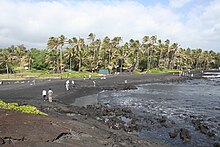
Punaluʻu Black Sand Beach Park

Laʻaloa Bay, also known as "Magic Sands," located in Kailua-Kona
The Hilina Slump is a 4,760-cubic-mile (19,800 km3) section of the south slope of the Kīlauea volcano which is slipping away from the island. Between 1990 and 1993, Global Positioning System (GPS) measurements showed a southward displacement of about 4 inches (10 cm) per year.[19] Undersea measurements show that a "bench" has formed a buttress and that this buttress may tend to reduce the likelihood of future catastrophic detachment.[20][21]
Earthquakes and tsunamis

Anaehoʻomalu Beach panorama
On 2 April 1868, an earthquake with a magnitude estimated between 7.25 and 7.9 rocked the southeast coast of Hawaii. This was the most destructive earthquake in the recorded history of Hawaii.[22] It triggered a landslide on Mauna Loa, 5 miles (8 km) north of Pahala, killing 31 people. A tsunami claimed 46 more lives. The villages of Punaluʻu, Nīnole, Kawaa, Honuapo, and Keauhou Landing were severely damaged. The tsunami reportedly rolled over the tops of the coconut trees up to 60 feet (18 m) high, and it reached inland a distance of a quarter of a mile (400 meters) in some places.[23]
On 29 November 1975, a 37-mile-wide (60 km) section of the Hilina Slump dropped 11.5 feet (3.5 m) and slid 26 feet (7.9 m) toward the ocean. This movement caused a 7.2 magnitude earthquake and a 48-foot-high (15 m) tsunami. Oceanfront property was washed off its foundations in Punaluu. Two deaths were reported at Halape, and 19 other people were injured.[24]
The island suffered tsunami damage from earthquakes in Alaska on 1 April 1946, and in Chile on 23 May 1960. Downtown Hilo was severely damaged by both tsunamis, with many lives lost. Just north of Hilo, Laupāhoehoe lost 16 schoolchildren and five teachers in the tsunami of 1946.[25]
In March 2011, a 9.0 magnitude earthquake off the east coast of Japan again created a tsunami that caused minor damage in Hawaii. The estimated damage to public buildings alone was about US$3 million.[26] In the Kona area this tsunami washed a house into Kealakekua Bay, destroyed a yacht club and tour boat offices in Keauhou Bay, caused extensive damage in Kailua Kona, flooded the ground floor of the King Kamehameha Hotel,[27] and permanently closed the Kona Village Resort.[28]
In early May 2018, hundreds of small earthquakes were detected on Kīlauea's East rift zone, leading officials to issue evacuation warnings. On 3 May 2018, the volcano erupted in Puna after a 5.0 earthquake earlier in the day, causing evacuations of the Leilani Estates and Lanipuna Gardens subdivisions.[29][30] A seemingly related 5.3 magnitude quake and a subsequent 6.9 magnitude earthquake occurred on 4 May.[31][32]
Volcanic fog
Vog (volcanic fog) can envelop the island. The gas plumes of the Kīlauea Volcano create a blanket of vog which the dominant trade winds mostly deflect toward the Kona coast on the west side of the island of Hawaiʻi. Vog contains chemicals that can damage the environment and the health of plants, humans, and other animals. Most of the aerosols are acidic and of a size where they can remain in the lungs to damage them and impair function. Flu-like symptoms and general lethargy are reported, and are especially pronounced in people with respiratory conditions.[33][34][35][36]
National protected areas
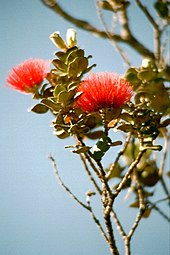
Lehua blossoms, Hawaiʻi
- Ala Kahakai National Historic Trail
- Hakalau Forest National Wildlife Refuge
- Hawaiʻi Volcanoes National Park
- Honokōhau Settlement and Kaloko-Honokōhau National Historical Park
Kohala Historical Sites State Monument (Mookini Heiau)- Kona Forest National Wildlife Refuge
- Puʻuhonua o Hōnaunau National Historical Park
- Puʻukoholā Heiau National Historic Site
Adjacent counties
Maui County – northwest
Demographics
| Historical population | |||
|---|---|---|---|
| Census | Pop. | %± | |
| 1900 | 46,843 | — | |
| 1910 | 55,382 | 18.2% | |
| 1920 | 64,895 | 17.2% | |
| 1930 | 73,325 | 13.0% | |
| 1940 | 73,276 | −0.1% | |
| 1950 | 68,350 | −6.7% | |
| 1960 | 61,332 | −10.3% | |
| 1970 | 63,468 | 3.5% | |
| 1980 | 92,053 | 45.0% | |
| 1990 | 120,317 | 30.7% | |
| 2000 | 148,677 | 23.6% | |
| 2010 | 185,079 | 24.5% | |
| Est. 2013 | 190,821 | 3.1% | |
| U.S. Decennial Census[37] 1790–1960[38] 1900–1990[39] 1990–2000[40] 2010–2013[5] | |||
As of the census[41] of 2010, the island had a resident population of 185,079. There were 64,382 households in the county. The population density was 17.7/km2 (45.9/mi2). There were 82,324 housing units at an average density of 8/km2 (20/mi2). The racial makeup of the county was 34.5% White, 0.7% African American, 22.6% Asian, 12.4% Native Hawaiian or other Pacific Islander, and 29.2% from two or more races; 11.8% of the population were Hispanics or Latinos of any race.[citation needed]
There were 64,382 households out of which 32.2% had children under the age of 18 living with them, 50.6% were married couples living together, 13.2% had a woman whose husband did not live with her, and 30.4% were non-families. 23.1% of all households were made up of individuals and 8.0% had someone living alone who was 65 years of age or older. The average household size was 2.75 and the average family size was 3.24.[citation needed]
The age distribution was 26.1% under 18, 8.2% from 18 to 24, 26.2% from 25 to 44, 26.0% from 45 to 64, and 13.5% who were 65 or older. The median age was 39 years. For every 100 females, there were 100 males. For every 100 females age 18 and over, there were 98 males.[citation needed]
41.3% of the people on Hawai`i island are religious, meaning they affiliate with a religion. 18.4% are Catholic; 3.7% are of another Christian faith; 5.1% are LDS; 0.1% in Hawaii, 5.0% are of an eastern faith; 0.1% are Muslim.[citation needed]

Downtown Kona

Downtown Hilo
Government and infrastructure
County government
Hawaii County encompasses the entire island of Hawaii. Executive authority is vested in the mayor of Hawaii County, who is elected for a four-year term. Since 2004, the election by the voters has been on a non-partisan basis. In 2008, Billy Kenoi was elected mayor, succeeding Harry Kim who had served a two-term limit.[42] Legislative authority is vested in a nine-member county council. Each member represents a geographical region of the island, which closely correlates to one of the nine tax map districts of Hawaiʻi County. Members of the county council are elected on a non-partisan basis to two-year terms, with elections occurring in November of even-numbered years.
Administrative districts were originally based on the traditional land divisions called Moku of ancient Hawaii. Some of the more heavily populated districts have since been split into North and South districts to make them more comparable on a population basis.[43]
The number preceding each district is the Tax Map Key (TMK) number, used to locate state property information. They are assigned in a counter-clockwise order, beginning on the eastern side of the island.[44]
| Nr. | District | Area mi2 | Population 2000 | moku | Map |
|---|---|---|---|---|---|
| 1 | Puna | 499.45 | 31335 | Puna | 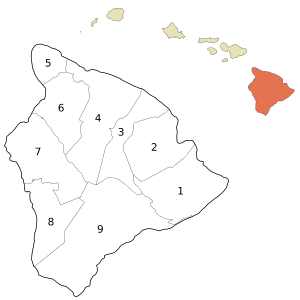 |
| 2 | South Hilo | 394.38 | 47386 | Hilo | |
| 3 | North Hilo | 370.65 | 1720 | Hilo | |
| 4 | Hāmākua | 580.50 | 6108 | Hāmākua | |
| 5 | North Kohala | 132.92 | 6038 | Kohala | |
| 6 | South Kohala | 351.72 | 13131 | Kohala | |
| 7 | North Kona | 489.01 | 28543 | Kona | |
| 8 | South Kona | 335.38 | 8589 | Kona | |
| 9 | Kaʻū | 922.22 | 5827 | Kaʻū | |
| Hawaiʻi County | 4028.02 | 148677 | 6 moku |
County council districts do not directly match the property tax districts because of the variation in the population density of voters in urban areas to rural areas; Hilo and Kailua (Kailua-Kona) towns are densely populated areas, while other districts such as Kaʻū, Puna, Hāmakua, and North & South Kohala are more sparsely populated.[45]
Several government functions are administered at the county level that are at the state or municipal level in other states. For example, the county has its own office of liquor control.[46]
State government
The Hawaii Department of Public Safety previously operated the Kulani Correctional Facility on the island of Hawaii.[47] In 2009, the Hawaii Department of Public Safety announced that the facility would close.[48]
Economy

Aerial view of Cyanotech Corp. microalgae ponds at NELHA
Sugarcane was the backbone of the island of Hawaiʻi's economy for more than a century. In the mid-20th century, sugarcane plantations began to downsize, and in 1996 the last plantation closed.[citation needed]
Most of the island's economy is based on tourism, centered primarily in resort areas on the western coast of the island in the North Kona and South Kohala districts. More recently, Hawaiʻi Island has become a focus for sustainable tourism.[citation needed]
Diversified agriculture is a growing sector of the economy. Major crops include macadamia nuts, papaya, flowers, tropical and temperate vegetables, and coffee beans. Only coffee grown in the Kona District of this island may be branded Kona coffee. The island's orchid agriculture is the largest in the state, and resulted in the unofficial nickname "The Orchid Isle". The island is home to one of the United States' largest cattle ranches: Parker Ranch, on 175,000 acres (708 km2) in Waimea. The island is also known for astronomy, with numerous telescopes operated on the summit of Mauna Kea, where atmospheric clarity is excellent and there is little light pollution.[citation needed]
NELHA (Natural Energy Laboratory of Hawaii Authority), a 675-acre (273 ha) state developed site, is a green economic development ocean science and technology park on the west side of the island. It provides resources and facilities for energy and ocean-related research, education, and commercial activities in an environmentally sound and culturally sensitive manner. Business tenants on this coastal site include microalgae farms, aquaculture, solar technology and marine biotech. Tenants have access to three sets of pipelines delivering deep-sea water from a depth of up to 3,000 feet (910 m), as well as pristine sea surface water and almost constant sunshine. A 2012 study by the University of Hawaii Economic Research Organization (UHERO) found the total economic impact of activities at NELHA was $87.7 million and created 583 jobs.[49]
Top employers
According to the county's 2010 Comprehensive Annual Financial Report,[50] the top employers in the county are:[citation needed]
| # | Employer | # of Employees |
|---|---|---|
| 1 | State of Hawaii | 8,115 |
| 2 | Hawaii County | 2,745 |
| 3 | United States Government | 1,364 |
| 4 | Hilton Waikoloa Village | 984 |
| 5 | Wal-Mart | 852 |
| 6 | KTA Super Stores | 800 |
| 7 | Mauna Loa Resort | 685 |
| 8 | The Fairmont Orchid | 577 |
| 9 | Four Seasons Resort Hualalai | 562 |
| 10 | Hapuna Beach Prince Hotel | 487 |
Education
- University of Hawaiʻi at Hilo
- University of the Nations
- Hawaiʻi Community College
Transportation

Bus in Hilo
Roads
Three routes connect the two major towns, Hilo on the east coast and Kailua-Kona on the west coast of the island:[51]
- State highways 19 & 190, the northern route via Waimea
- State highway 11, the southern route via Hawaii Volcanoes National Park
- Saddle Road (aka the Daniel K. Inouye Memorial highway), passing between Mauna Loa and Mauna Kea).
There are also State highways 270 (Kawaihae – Hawi) and 180 (the "Kona coffee road", from Honalo to State highway 190), South Point Road (Highway 11 to South Point), etc.
There are presently three Hawaii Scenic Byways on the island of Hawaii:
- Mamalahoa Kona Heritage Center
- Royal Footsteps Along the Kona Coast
- Kaʻu Scenic Byway – The Slopes of Mauna Loa
Rental car offices are at the international airports. Taxi service is also available. Island-wide bus service is provided by the "Hele-On Bus".[52]
Airports
Two commercial airports serve Hawaiʻi Island:
Hilo International Airport (ITO)
Kona International Airport (KOA)
There is also:
Waimea-Kohala Airport (MUE)
Upolu Airport (UPP)
Seaports
Major commercial ports are Hilo on the east side and Kawaihae on the west side of the island. Cruise ships often stop at Kailua-Kona (90 times in 2017)[53] and Hilo (108 times in 2017).[54]
Places of interest

ʻAkaka Falls on Kolekole Stream

Green sea turtle lying on an old lava flow; the background shows a Hawaiian temple, known as a "heiau" in the Hawaiian language.
Akaka Falls, one of the tallest waterfalls on the island.
Amy B. H. Greenwell Ethnobotanical Garden houses many endangered endemic plants.- East Hawaiʻi Cultural Center
- Hawaiʻi Tropical Botanical Garden
Hawaiʻi Volcanoes National Park, comprising the active volcanoes Kīlauea and Mauna Loa
Huliheʻe Palace, a royal palace in Kailua-Kona
ʻImiloa Astronomy Center of Hawaiʻi in Hilo
Ka Lae, the southernmost point in the United States
Laupāhoehoe Train Museum
Lyman House Memorial Museum in Hilo- Manuka State Wayside Park
- Mauna Kea Observatories
- Nani Mau Gardens
- Onizuka Center for International Astronomy
Pacific Tsunami Museum overlooking Hilo Bay
Pana'ewa Rainforest Zoo in Hilo- Pua Mau Place Arboretum and Botanical Garden
- Puʻuhonua o Hōnaunau National Historical Park
Puʻukoholā Heiau National Historic Site, the site of one of the most significant heiau in Hawaii- Rainbow Falls State Park
- Sadie Seymour Botanical Gardens
- Umauma Falls
- University of Hawaiʻi at Hilo Botanical Gardens
- Waipiʻo Valley
- Wao Kele o Puna
- World Botanical Gardens
Maps
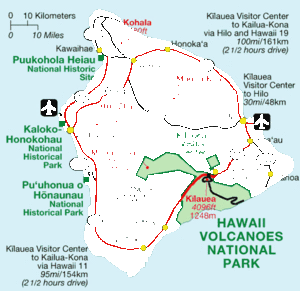
National parks, mountains and cities on the island

Topographic map of the island of Hawaii
[http://upload.wikimedia.org/wikipedia/commons/2/29/Hawaii_Island_topographic_map_SMIL.svg (interactive 3D model for Chrome or Firefox)
Communities
The island was traditionally divided into districts called moku. The names of the districts are (counter-clockwise, from the southeast): Puna, Hilo, Hāmākua, Kohala, Kona, and Kaʻū. The county government subdivides some of these to form elective districts of the county council. There are no incorporated municipalities on the island.[citation needed]
Census-designated places
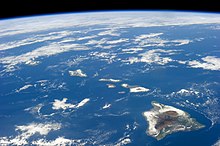
Hawaii from space, 26 January 2014[55]
- Ainaloa
- Captain Cook
- Eden Roc
- Fern Acres
- Fern Forest
- Halaula
- Hawaiian Acres
- Hawaiian Beaches
- Hawaiian Ocean View
- Hawaiian Paradise Park
- Hawi
- Hilo
- Holualoa
- Honalo
- Honaunau-Napoopoo
- Honokaa
- Honomu
- Kahaluu-Keauhou
- Kailua
- Kalaoa
- Kapaau
- Keaau
- Kealakekua
- Keokea
- Kukuihaele
- Kurtistown
- Laupahoehoe
- Leilani Estates
- Mountain View
- Naalehu
- Nanawale Estates
- Orchidlands Estates
- Paauilo
- Pahala
- Pahoa
- Papaikou
- Pepeekeo
- Paukaa
- Puako
- Volcano
- Waikoloa Village
- Waimea
- Wainaku
Unincorporated communities
- Ahualoa
- Hakalau
- Waiohinu
See also
- National Register of Historic Places listings on the island of Hawaii
References
^ "Summit USGS 1977". NGS data sheet. U.S. National Geodetic Survey. Retrieved 18 August 2010..mw-parser-output cite.citationfont-style:inherit.mw-parser-output .citation qquotes:"""""""'""'".mw-parser-output .citation .cs1-lock-free abackground:url("//upload.wikimedia.org/wikipedia/commons/thumb/6/65/Lock-green.svg/9px-Lock-green.svg.png")no-repeat;background-position:right .1em center.mw-parser-output .citation .cs1-lock-limited a,.mw-parser-output .citation .cs1-lock-registration abackground:url("//upload.wikimedia.org/wikipedia/commons/thumb/d/d6/Lock-gray-alt-2.svg/9px-Lock-gray-alt-2.svg.png")no-repeat;background-position:right .1em center.mw-parser-output .citation .cs1-lock-subscription abackground:url("//upload.wikimedia.org/wikipedia/commons/thumb/a/aa/Lock-red-alt-2.svg/9px-Lock-red-alt-2.svg.png")no-repeat;background-position:right .1em center.mw-parser-output .cs1-subscription,.mw-parser-output .cs1-registrationcolor:#555.mw-parser-output .cs1-subscription span,.mw-parser-output .cs1-registration spanborder-bottom:1px dotted;cursor:help.mw-parser-output .cs1-ws-icon abackground:url("//upload.wikimedia.org/wikipedia/commons/thumb/4/4c/Wikisource-logo.svg/12px-Wikisource-logo.svg.png")no-repeat;background-position:right .1em center.mw-parser-output code.cs1-codecolor:inherit;background:inherit;border:inherit;padding:inherit.mw-parser-output .cs1-hidden-errordisplay:none;font-size:100%.mw-parser-output .cs1-visible-errorfont-size:100%.mw-parser-output .cs1-maintdisplay:none;color:#33aa33;margin-left:0.3em.mw-parser-output .cs1-subscription,.mw-parser-output .cs1-registration,.mw-parser-output .cs1-formatfont-size:95%.mw-parser-output .cs1-kern-left,.mw-parser-output .cs1-kern-wl-leftpadding-left:0.2em.mw-parser-output .cs1-kern-right,.mw-parser-output .cs1-kern-wl-rightpadding-right:0.2em
^ "Hawaii Island Flower – Red Pua Lehua ('Ohi'a blossom)". statesymbolsusa.org. State Symbols USA. 31 July 2012. Archived from the original on 2 August 2012. Retrieved 3 August 2012.
^ "List of the Islands of Polynesia". Archived from the original on 1 January 2017.
^ According to the Geographic Names Information System, Island of Hawaiʻi is the preferred name, see U.S. Geological Survey Geographic Names Information System: Island of Hawaiʻi.
^ ab "State & County QuickFacts". United States Census Bureau. Archived from the original on 11 July 2011. Retrieved 28 June 2014.
^ Geography, US Census Bureau. "2010 Geographic Terms and Concepts – Place". www.census.gov. Archived from the original on 19 February 2014.
^ Jarves, James Jackson (1843). History of the Hawaiian or Sandwich Islands. Tappa et Dennet. p. 1.
^ "History – Captain James Cook". BBC. 1 January 1970. Archived from the original on 16 October 2014. Retrieved 8 August 2014.
^ Homans, Margaret; Munich, Adrienne. Remaking Queen Victoria. Cambridge University Press. p. 147. ISBN 978-0-521-57485-3.
^ "US Gazetteer files: 2010, 2000, and 1990". United States Census Bureau. 12 February 2011. Archived from the original on 12 March 2012. Retrieved 23 April 2011.
^ Delaware's Sussex County comes in second at 48.0 percent, while Rhode Island's Providence County is third at 39.6 percent.
^ "Table 5.08 – Land Area of Islands: 2000" (PDF). State of Hawaii Data Book. State of Hawaii. 2004. Archived (PDF) from the original on 29 February 2012. Retrieved 12 February 2010.
^ "Highest Mountain in the World". Archived from the original on 2 April 2016. Retrieved 4 April 2016.
^ "Frequently Asked Questions – Hawai'i Volcanoes National Park". www.nps.gov. U.S. National Park Service. Archived from the original on 6 August 2017. Retrieved 6 November 2017.
^ MacDonald, G. A.; Abbott, A. T. (1970). Volcanoes in the Sea. Honolulu: University of Hawaiʻi Press. ISBN 0-87022-495-6.
^ Moore, James G.; Clague, David A. (November 1992), "Volcano growth and evolution of the island of Hawaii" (PDF), Bulletin of the Geological Society of America, 104 (11): 1471–1484, doi:10.1130/0016-7606(1992)104<1471:VGAEOT>2.3.CO;2, p. 1471.
^ Garcia, Michael; Hanano, Diane (March 2008). "Age, geology, geophysics, and geochemistry of Mahukona Volcano, Hawai`i" (PDF). Bulletin of Volcanology. 74 (6): 1445–63. Bibcode:2012BVol...74.1445G. doi:10.1007/s00445-012-0602-4. Archived (PDF) from the original on 26 August 2015. Retrieved 14 December 2016.
^ ab "Are We Breaking Away – The Great Crack" Archived 10 May 2009 at the Wayback Machine, USGS, 16 July 1998.
^ Owen, Susan; Segal, Paul; Freymueller, Jeff; et al. (1995). "Rapid Deformation of the South Flank of Kilauea Volcano, Hawaii". Science. 267 (5202): 1328–32. Bibcode:1995Sci...267.1328O. doi:10.1126/science.267.5202.1328.
^ Morgan, J. K.; Moore, G. F.; Clague, D. A. (2003). "Slope failure and volcanic spreading along the submarine south flank of Kilauea volcano, Hawaii". Journal of Geophysical Research. 108 (B9): 2415. Bibcode:2003JGRB..108.2415M. doi:10.1029/2003JB002411.
^ "Hawaiian Landslides – Slope failure on Kilauea's submarine south flank (Subsection)". Monterey Bay Aquarium Research Institute. Archived from the original on 27 May 2009. Retrieved 15 September 2009.
^ Hawaiian Volcano Observatory (26 October 2006) "Destructive Earthquakes in Hawai`i County Since 1868" Archived 25 August 2009 at the Wayback Machine. Retrieved 21 March 2012
^ Walter C. Dudley (1998). Tsunami! (second ed.). University of Hawaii Press. pp. 222–24. ISBN 978-0-8248-1969-9.
^ Pararas-Carayannis, George. "Hawaii – Earthquake and Tsunami of 29 November 1975 in the Hawaiian Islands". www.drgeorgepc.com. Archived from the original on 1 January 2017.
^ "April 1, 1946: Have we learned enough since tsunami that killed 159 in Hawai'i?". the.honoluluadvertiser.com. The Honolulu Advertiser | Hawaii's Newspaper. Archived from the original on 8 March 2016.
^ Nakaso, Dan (14 March 2011) "Tsunami damage estimate for Hawaii now tens of millions" Archived 15 March 2011 at the Wayback Machine. Star Advertiser, Retrieved 15 March 2011
^ "King Kamehameha Hotel is new and improved after last year's tsunami". KHON2. Archived from the original on 8 January 2014. Retrieved 1 April 2012.
^ "Tsunami damage forces closing of Kona Village Resort". Archived from the original on 1 January 2017.
^ "Kilauea volcano in Hawaii could erupt after hundreds of small earthquakes". Retrieved 5 May 2018.
^ "Ige signs emergency proclamation following Leilani lava eruption". www.hawaiitribune-herald.com. Hawaii Tribune-Herald. Retrieved 5 May 2018.
^ "Overnight, earthquakes and lava become the new norm on Hawaii island". 3 May 2018. Retrieved 5 May 2018.
^ "M 6.9 – 16km SW of Leilani Estates, Hawaii". earthquake.usgs.gov. Retrieved 4 May 2018.
^ "Archived copy". Archived from the original on 27 May 2010. Retrieved 29 December 2009.CS1 maint: Archived copy as title (link) on USGS web site. U.S. Geological Service. Retrieved 29 December 2009.
^ "Archived copy". Archived from the original on 5 February 2012. Retrieved 4 July 2015.CS1 maint: Archived copy as title (link) on USGS web site.
^ "Archived copy". Archived from the original on 5 July 2015. Retrieved 4 July 2015.CS1 maint: Archived copy as title (link) on "Airnow" US Government web site.
^ "Archived copy". Archived from the original on 22 February 2012. Retrieved 4 July 2015.CS1 maint: Archived copy as title (link) on State of Hawaii Office of the Governor web site.
^ "U.S. Decennial Census". United States Census Bureau. Archived from the original on 12 May 2015. Retrieved 28 June 2014.
^ "Historical Census Browser". University of Virginia Library. Archived from the original on 16 August 2012. Retrieved 28 June 2014.
^ "Population of Counties by Decennial Census: 1900 to 1990". United States Census Bureau. Archived from the original on 6 August 2013. Retrieved 28 June 2014.
^ "Census 2000 PHC-T-4. Ranking Tables for Counties: 1990 and 2000" (PDF). United States Census Bureau. Retrieved 28 June 2014.
^ "American FactFinder". United States Census Bureau. Archived from the original on 11 September 2013. Retrieved 14 May 2011.
^ "Office of the Mayor". official web site. County of Hawaii. Archived from the original on 8 July 2011. Retrieved 27 March 2010.
^ "Ahupua`a". Hawaii History. Info Grafik. Retrieved 17 January 2018.
^ County Of Hawaii
^ "Hawaiʻi County Council". official web site. Archived from the original on 8 July 2011. Retrieved 27 March 2010.
^ "Office of Liquor Control". Hawaii County web site. Archived from the original on 23 November 2010. Retrieved 25 December 2010.
^ "Kulani Correctional Facility Archived 13 August 2012 at the Wayback Machine." Hawaii Department of Public Safety. Retrieved on 30 September 2010.
^ "Closure of Kulani Saves $2.8M Annually; Facility to Help At-Risk Youth." Hawaii Department of Public Safety. July 2009. Retrieved on 30 September 2010.
^ University of Hawaii Economic Research Organization (UHERO) (18 May 2012). "Economic Impact of the Natural Energy Laboratory Hawaii Authority Tenants on the State of Hawaii" (PDF). nelha.hawaii.gov. Honolulu, HI: University of Hawaii. Archived (PDF) from the original on 9 August 2014. Retrieved 7 August 2014.
^ County of Hawaii CAFR Archived 29 September 2011 at the Wayback Machine
^ The maps in the This Week Archived 7 November 2014 at the Wayback Machine Big Island Magazine
^ Hele-On Bus website Archived 3 May 2009 at the Wayback Machine retrieved 2009-045-08
^ "List of cruise ships that visit Kailua Kona". lovebigisland. Archived from the original on 2 January 2017. Retrieved 1 January 2017.
^ "List of cruise ships that visit Hilo". lovebigisland. Archived from the original on 2 January 2017. Retrieved 1 January 2017.
^ "Hawaii: Image of the Day". 29 January 2014. Archived from the original on 10 January 2015. Retrieved 4 April 2016.
External links
![]() Media related to Hawaii (island) at Wikimedia Commons
Media related to Hawaii (island) at Wikimedia Commons![]() Media related to Hawaii County, Hawaii at Wikimedia Commons
Media related to Hawaii County, Hawaii at Wikimedia Commons
- Official Hawaii County website
- Hawai'i Volcanoes National Park official website
Hawaii (island) at Encyclopædia Britannica
Hawaii Tribune-Herald – official website of the Hawaii Tribune-Herald, a daily newspaper in Hilo
West Hawaii Today – official website of West Hawaii Today
Island of Hawaii from the International Space Station – NASA satellite image, taken from the International Space Station on 28 February 2015
Hawaii (island) at Curlie Media related to Hawaii (island) at Wikimedia Commons
Media related to Hawaii (island) at Wikimedia Commons
Coordinates: 19°34′N 155°30′W / 19.567°N 155.500°W / 19.567; -155.500






